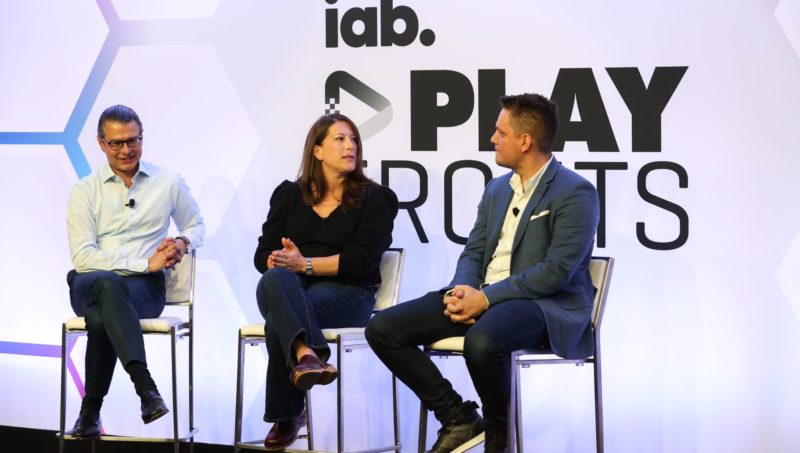Brands are tip-toeing into immersive VR experiences, also known as the metaverse, through the gaming world. There are a wide range of options for brands to connect with the otherwise elusive gaming audience.
This led the discussion at IAB’s first-ever PlayFronts, an event dedicated to advertising and partnership opportunities in the gaming industry. The New York event showed marketers a crash course about the metaverse and how games are part of that. The road to games has been widened by powerhouse gaming publishers like Activision Blizzard (acquired by Microsoft in a jaw-dropping deal), media publishers like NBCUniversal and the adtech leaders who are connecting the pipes to playable ads and virtual metaverse activations.
“They say COVID was an acceleration for gaming, I believe this event will be an acceleration for gaming as an advertising medium,” said Itamar Benedy, co-founder and CEO of programmatic in-game advertising platform Anzu. “People who told me three years ago that I have a cool startup, but those geeks locked in their basement aren’t their audience – they’re at this conference, so I guess there’s a change in perception on that.”
Games and gamers are already using decentralized virtual environments And they are a core audience for brands looking for newer, younger customers they can’t find through other channels.
Untapped audiences identify as gamers
“It’s difficult to reach the gaming audience because they aren’t watching linear TV or streaming or other media,” said Zoe Soon, vice president of the Experience Center at IAB.
The gaming audience is also diverse, with 46% of U.S. gamers being female and 71% of U.S. moms playing games. And games become even more prevalent with younger audiences, Soon said. For Gen Z, 80% consider themselves gamers. One study shared at the conference found that only 10% of children ages six to 16 consider themselves not gamers.
Brands like Acura see metaverse activations as a way to reach untapped audiences and new customers. That’s because if you don’t advertise in or around games, you won’t reach many of these gamers.
With high-profile music acts like Ariana Grande and Marshmello involved in the gaming scene and collaborating with gaming publishers, Soon pointed to a broader cultural impact that brands can tap into, as like Balenciaga and Gucci have.
Programmatic gaming ads in the metaverse
“In-game advertising has the ability to dynamically change the content in the game to personalize at the device level, to sell it in a programmatic way to make the game more realistic,” said Benedy. “It also works within the whole advertising ecosystem around fraud detection, brand lift, brand impact, attention, distribution and even up to offline attribution.”
This year, Anzu partnered with NBCUniversal’s One Platform ad solution, to make gaming part of a holistic strategy. Anzu’s mobile, PC, console and Roblox deployments can now be part of a broader holistic media strategy for advertisers including streaming, audio and out-of-home.
Key advertisers are aware that gaming is one of the most rapidly-growing media in advertising, said Krishan Bhatia, President and chief business officer, global advertising and partnerships for NBCUniversal. He added that they weren’t sure about how a campaign could be executed at scale. That’s where a programmatic partnership comes into play, so marketers have the same control as more established media channels.
As gaming’s role in the ad ecosystem evolves, it offers more control to brands and their programmatic and media buying partners to manage brand safety.
“Leaving aside the ongoing debate as to whether violent content is actually detrimental to brand image, where there’s no conclusive research to show that, gaming offers advertisers so much control in terms of where their ad is placed, frame-by-frame,” said Soon.
Executing a holistic game plan
Bhatia also said that marketers have a great need for premium content, which would include some of the most popular global games and franchises. Alongside that, NBCUniversal’s premium streaming app Peacock is also ad-supported, as opposed to streamers like Netflix.
For brand placements in virtual gaming worlds like Roblox, it’s not just an in-game ad, but instead referred to as an experience – much like an experiential placement at a real world conference or event.
Last month, Anzu helped American Eagle launch a “Members Always Club” activation in Roblox. Specifically, the brand presence was located in a section of the territory called Livetopia. The metaverse promo was timed with a traditional and digital spring campaign featuring tennis star Coco Gauff, actress Madelyn Cline and other influential Gen Z figures.
“If we think about where our audience is, it’s in the metaverse,” said Ashley Schapiro, vice president, marketing, media, performance and engagement for American Eagle. “How do we take our campaign and bring it there? The answer was Roblox for us.”
Schapiro identified Livetopia as one of the top 10 roleplaying experiences on Roblox. This enabled Roblox gamers to visit the American Eagle experience, to play tennis or visit the on-site swimming pool, while also having the chance to try on the entire spring collection with their avatars.
Five million people tried on the collection in a month, Schapiro said. In the spirit of inclusivity, the brand allowed access for free instead of charging Robux, the Roblox currency.
“Gaming can no longer be seen as a fringe activity,” said Soon. “It’s mainstream and it’s everywhere.”
Source: https://martech.org/how-the-gaming-universe-is-preparing-marketers-for-the-metaverse/
